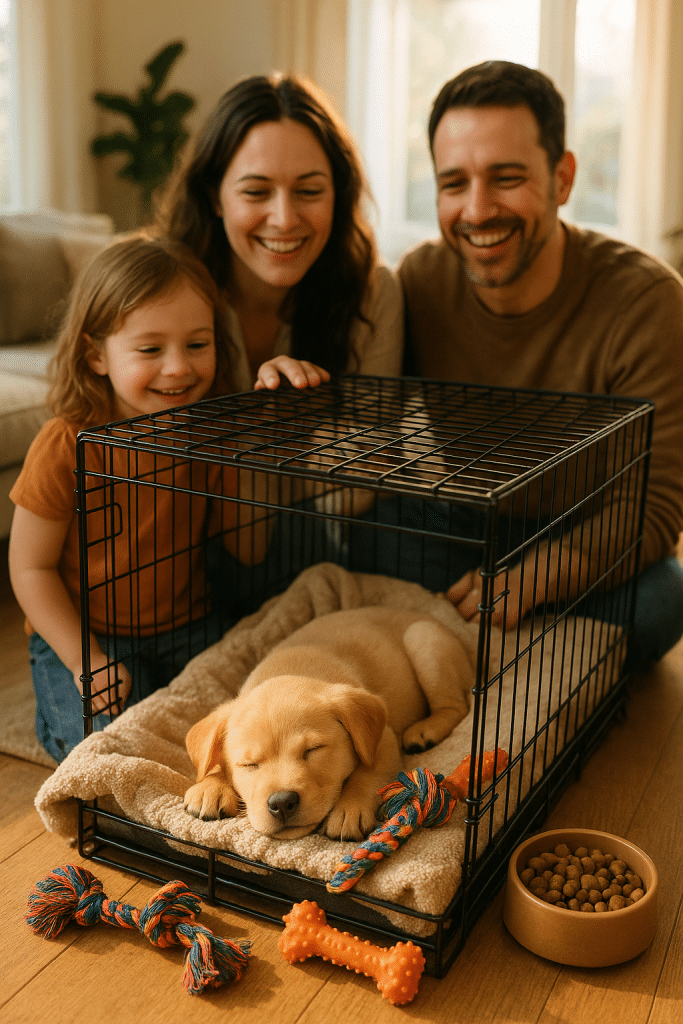Crate training a puppy is a cornerstone of responsible pet ownership that can yield rewarding results for both you and your new furry family member. If you’re like many pet owners and families seeking guidance on breeds and training, you might wonder exactly how to begin crate training, how long it should take, and what essentials you need for success. Crate training—far from just being a tool for confinement—is actually a way to provide your puppy with a safe retreat and an effective housebreaking method.
In this comprehensive article, I will walk you through the five crucial steps of crate training a puppy, including practical details on choosing the right crate, making it comfortable, and building a positive training routine. You’ll learn how to manage common challenges like puppy whining and anxiety, adjust training according to your dog’s breed and temperament, and integrate crate training into your wider family pet training routines. Whether you are a first-time puppy parent or looking to brush up on best practices, this guide blends expert insights, real-life examples, and step-by-step instructions to help you and your puppy thrive together.
Understanding the Benefits of Crate Training for Puppies and Families
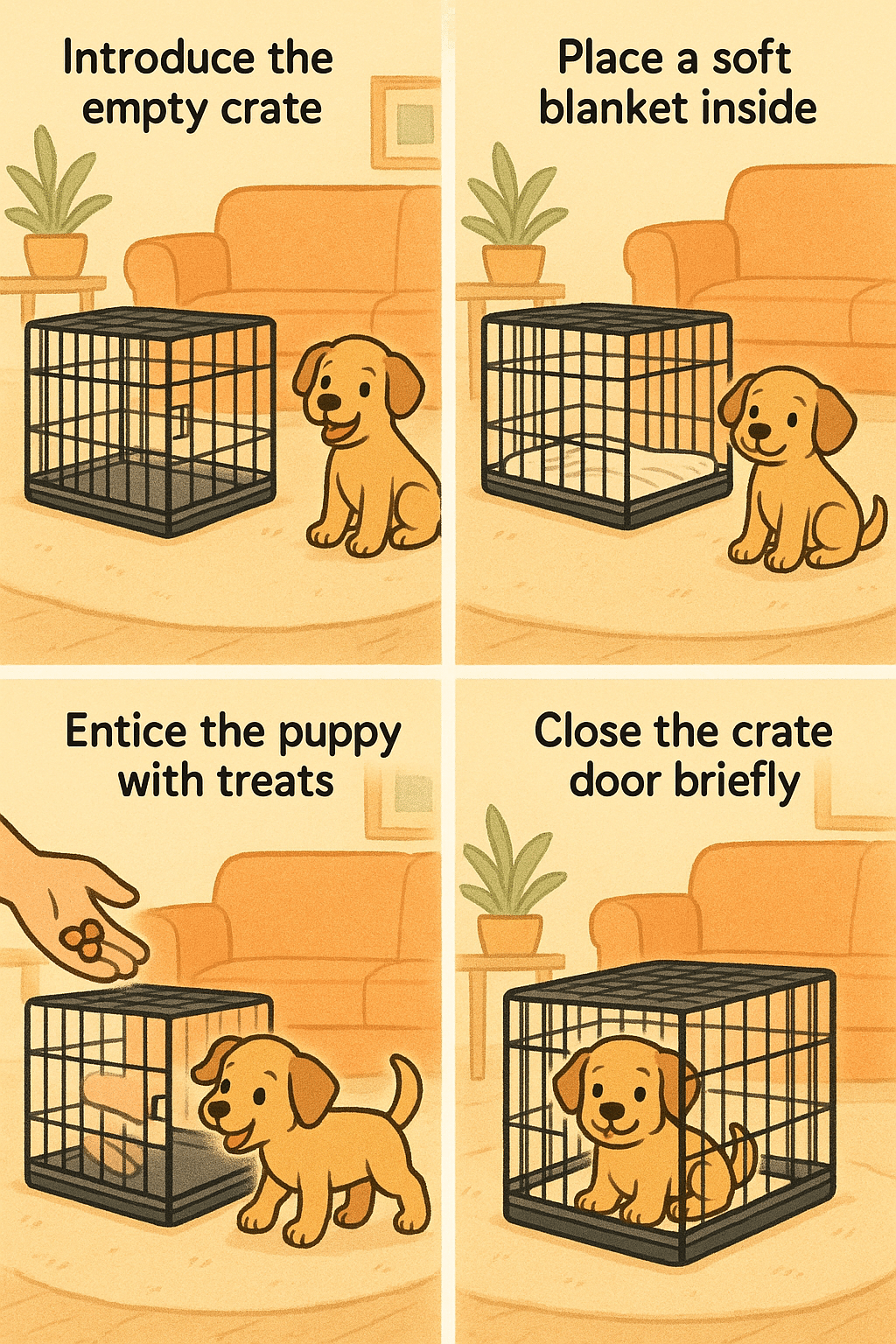
Before diving into the mechanics of crate training a puppy, it’s important to understand why this method is so highly recommended by veterinarians, trainers, and experienced pet owners. The first key benefit is that crates mimic a dog’s natural den. Dogs instinctively seek a secure, enclosed space where they can rest without disturbance. By offering a crate that feels like a cozy den, we tap into this natural behavior, helping puppies feel calm and protected.
Crate training also accelerates puppy housebreaking or potty training. Puppies naturally avoid soiling their sleeping area. When you confine them responsibly, you’re encouraging them to hold their bladder and bowels until you give them access to the outdoors. This reduces accidents in the house and teaches control gradually.
Furthermore, using a crate helps with managing destructive behaviors. Puppies are curious and chewing can quickly get out of hand. A crate keeps your puppy safe when you cannot directly supervise them, preventing injuries and household damage.
Lastly, crates facilitate easier travel, veterinary visits, and boarding, reducing stress for your puppy in unfamiliar environments. It also supports a peaceful home environment when family members need quiet or a break from puppy play.
By understanding these benefits, you can approach crate training not as a chore, but as an investment into your puppy’s well-being and long-term family harmony.
Selecting the Right Crate Size and Type for Your Puppy
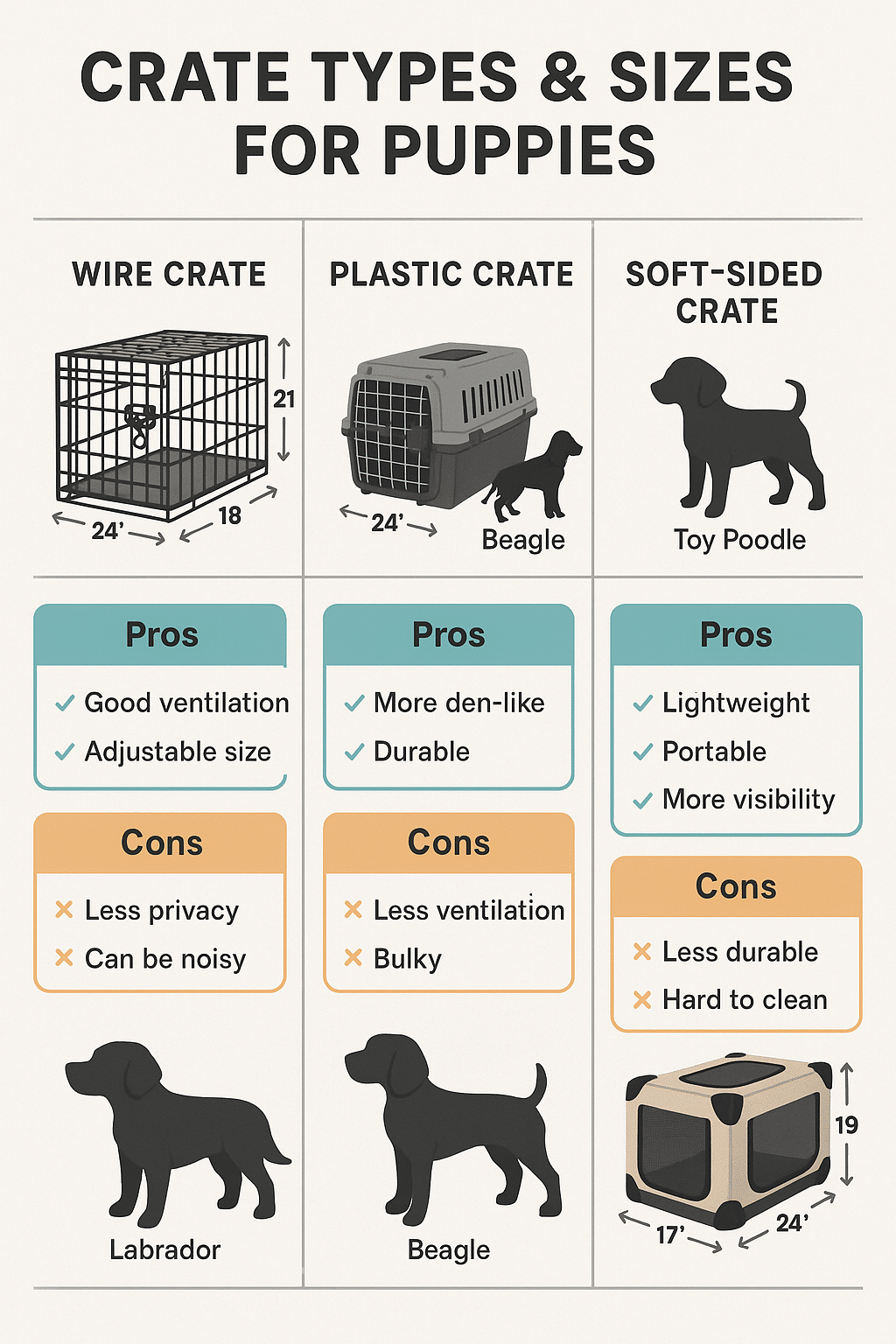
Choosing the perfect crate is foundational to successful crate training a puppy. The crate must be just the right size to be comfortable yet restrictive enough to prevent your puppy from using one corner as a bathroom.
Assessing Dog Crate Sizes Based on Breed and Growth
Puppies come in many sizes and grow quickly, so picking the right crate size requires foresight. The crate should be large enough for your puppy to stand up, turn around, and lie down comfortably, but it should not be spacious enough to allow them to eliminate in one corner and rest in another.
As a general guideline, you want the crate labeled with the approximate adult size of your puppy’s breed. For example:
- Small breeds (like Chihuahuas or Pomeranians) often require crates about 18-24 inches long.
- Medium breeds (like Beagles or Cocker Spaniels) will be comfortable in crates roughly 24-30 inches.
- Large breeds (like Labradors or German Shepherds) may need crates that are 36 inches or longer.
If your puppy is still small but expected to grow large, use a crate with a divider panel to adjust the living space over time. This means you can start with a smaller section and gradually open it up as your pup grows.
Comparing Dog Kennel vs Crate: Pros and Cons
While crates are typically enclosed wire or plastic boxes designed for indoor use, kennels are generally larger spaces, often used outdoors or for transport.
Crate Pros:
- Portable and light, easy to fold and store.
- Well-ventilated with good visibility for your puppy.
- Facilitates housebreaking via confinement.
Crate Cons:
- Limited space, might need adjustments with a growing pup.
- Not as versatile for outdoor use.
Kennel Pros:
- Larger and more spacious, ideal for active play or outdoor confinement.
- More durable and secure.
Kennel Cons:
- Can be bulky and less portable.
- May not be suitable for indoor overnight use.
Choosing between a crate and a kennel depends on your lifestyle, training goals, and housing setup. Most pet owners prioritize a sturdy crate indoors to start crate training a puppy efficiently.
Preparing and Making the Crate Comfortable for Your Puppy
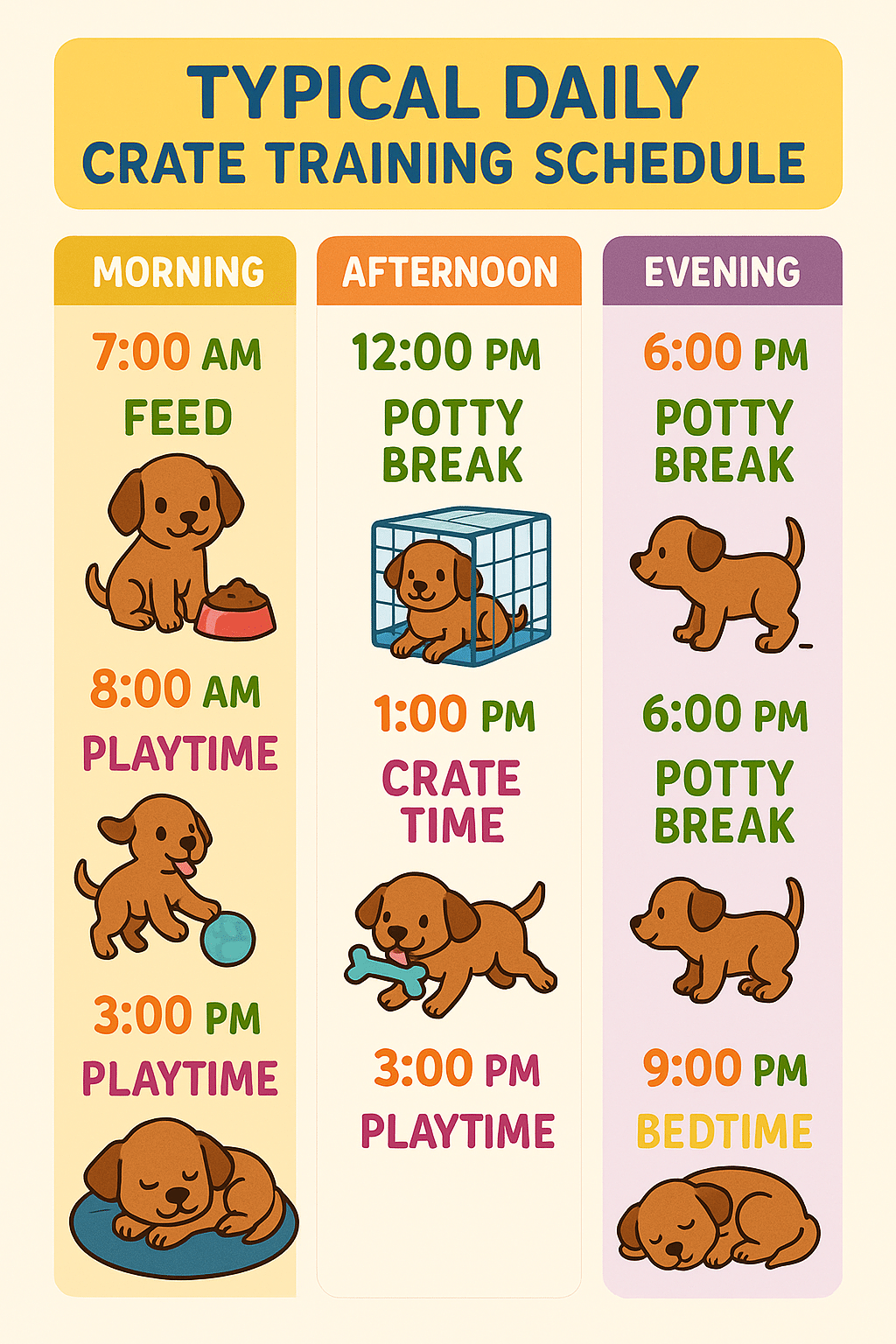
The crate should feel like a positive, inviting refuge for your puppy. How you prepare and outfit it plays a significant role in shaping your pup’s attitude toward the crate.
Creating a Cozy Den: Bedding, Toys, and Location
Begin with soft bedding that is washable and appropriate for the crate size. Avoid overly thick cushioning that might be hard to clean or could encourage your puppy to chew destructively. Orthopedic foam pads or washable fleece blankets work well.
Include safe chew toys and comfort items, such as a well-loved stuffed animal or a treat-dispensing toy, to encourage positive associations.
Location matters big time. Place the crate in a quiet corner but not isolated—near family activity zones so your puppy feels included but not overwhelmed. Avoid drafty areas or direct sunlight. Gentle background noise, such as a radio or white noise machine, can ease the transition.
Managing Puppy Anxiety and Stress During Crate Introduction
Some puppies experience anxiety when first introduced to their crate. To tackle this, keep crate sessions short and cheerful initially. Use soothing voice tones and lots of praise. Never force your puppy inside the crate or use it as punishment—that breeds fear.
If anxiety manifests as whining or barking, try calming strategies like giving a special treat only in the crate or feeding meals inside. Pheromone sprays designed for dogs can also soothe stress.
If your puppy is highly nervous, consider gradual desensitization—starting with just sitting beside the open crate, then tossing treats inside, then briefly closing the door.
With patience and positive reinforcement, you can help even the most nervous puppies enjoy their crate as a safe haven.
How to Crate Train a Puppy Step by Step Using Positive Reinforcement
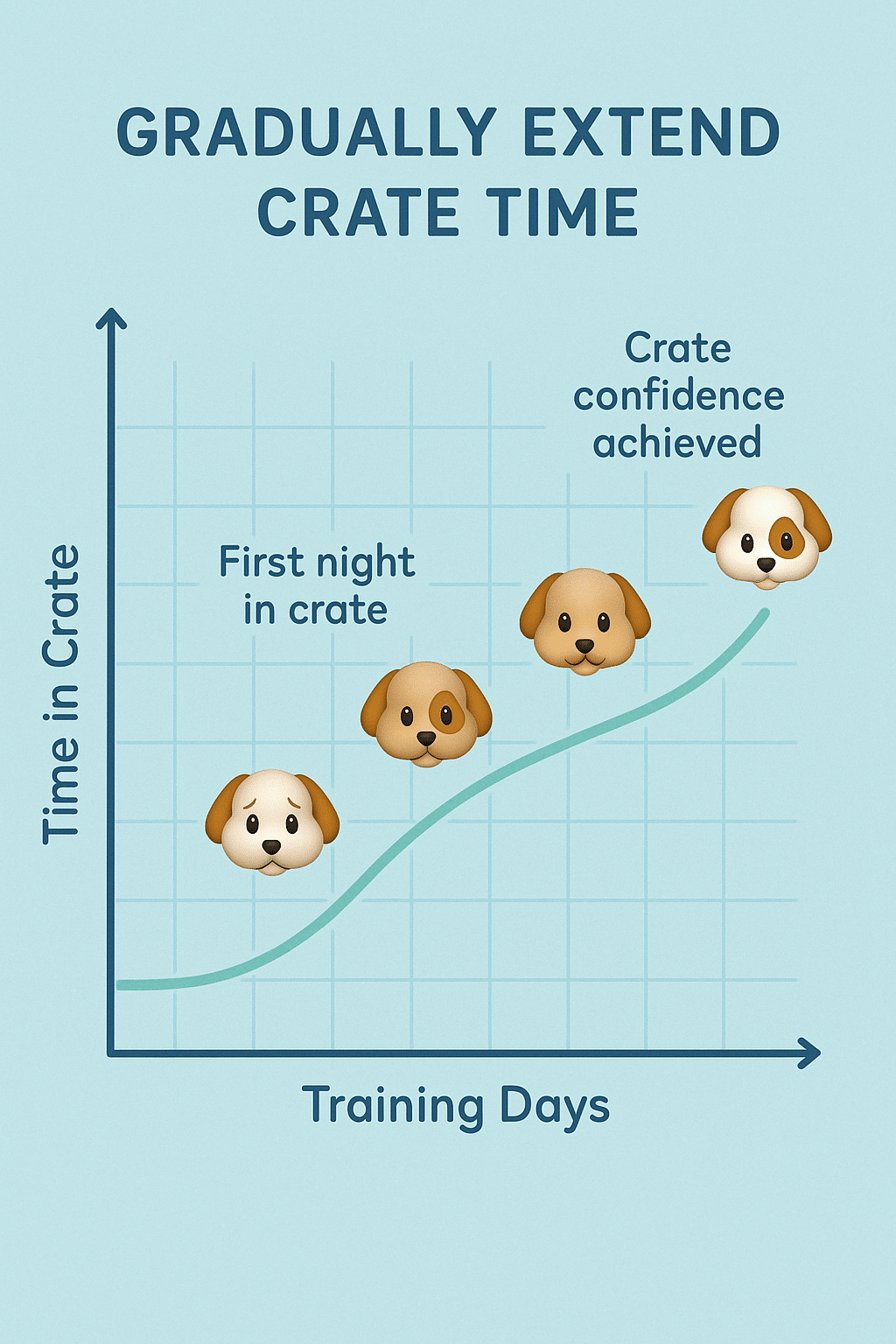
Now that you have the right crate and environment, it’s time to introduce crate training a puppy in a practical, stepwise fashion.
Introducing the Crate Gradually to Build Positive Associations
Start with the crate door open and toss in your puppy’s favorite treats or toys. Let them enter and exit freely, exploring without pressure. Praise warmly anytime your pup chooses to go inside.
Next, feed your puppy meals inside the crate, initially with the door open, then with it closed briefly as they eat. This reinforces a fun and rewarding experience.
Slowly increase the time your puppy spends inside with the door closed, starting from just a few seconds and adding duration as your pup becomes comfortable.
Using Meals and Reward-Based Training Methods to Encourage Crate Use
Food is one of the best motivators when crate training puppies. Give your puppy small treats whenever they voluntarily enter the crate. Use a happy voice to praise them.
If your puppy whines or scratches at the door, don’t rush to open it immediately—that may teach them that whining works. Wait for a moment of quiet before rewarding with freedom.
Consistency is key: always reward calm crate behavior and avoid negative reactions, ensuring your pup views the crate as positive.
Developing a Puppy Potty Training Schedule Aligned with Crate Time
Puppies have limited bladder control depending on age—generally one hour per month of age plus one hour. Plan frequent outdoor breaks aligned with crate time to prevent accidents.
Establish a routine of taking your puppy out immediately after crate sessions, first thing in the morning, after naps, playtime, and before bedtime.
Using crate time strategically helps your puppy learn to hold it and understand when bathroom breaks happen, reinforcing housebreaking success.
Establishing a Crate Training Schedule for Different Puppy Ages
Your puppy’s age influences how long they can safely stay crated and how the schedule should look.
Recommended Duration Limits to Prevent Stress and Ensure Comfort
- Puppies 8-10 weeks: limit crate time to 30 minutes to 1 hour when awake.
- Puppies 3-6 months: up to 2-3 hours in a crate during the day.
- Puppies 6+ months: can gradually handle 3-4 hours.
- Overnight crate time can extend up to 6-8 hours depending on puppy maturity.
Never leave your puppy in a crate for extended periods without breaks. Puppies need exercise, socialization, and bathroom opportunities.
Overnight Crate Training Tips for Better Sleep and Potty Control
Place the crate near your bedroom so your puppy feels close and is less anxious. You’ll be able to respond quickly if your puppy whines overnight to go outside.
Use a consistent bedtime routine that includes a bathroom trip, some calm play, and a relaxing crate session.
Avoid feeding or allowing water within 1-2 hours of bedtime to reduce nighttime wake-ups.
If whining persists, briefly reassure but avoid pulling your puppy out repeatedly—this helps them learn to settle on their own.
Addressing and Managing Puppy Whining and Behavioral Challenges
Whining is probably the most frustrating hurdle in crate training. But it’s usually temporary with the right techniques.
Effective Techniques to Ignore Whining without Causing Anxiety
The trick is to distinguish between whining for attention and an urgent need (like bathroom). If you know your puppy doesn’t need a potty break, wait until the whining stops before opening the door.
Distract your puppy with a chew toy or white noise. Reward silence immediately when it occurs.
Use a consistent response schedule so your pup understands that being quiet brings the desired outcome.
Avoiding Common Crate Training Mistakes and Behavioral Corrections
- Never use the crate as punishment.
- Avoid forcing your puppy inside.
- Don’t leave puppies crated too long.
- Avoid inconsistent training routines.
- Don’t open the crate during whining without first waiting for quiet.
By steering clear of these mistakes, you set your puppy up for positive crate experiences and behavioral success.
Crate Training Considerations Based on Puppy Breed and Temperament
Every puppy is unique, and their breed or natural temperament can influence crate training approaches.
Adapting Training Strategies to Breed-Specific Behavioral Traits
High-energy breeds like Border Collies or Jack Russell Terriers may require shorter crate periods and more frequent breaks with enrichment activities.
More independent or stubborn breeds like Afghan Hounds might respond better to slow introduction and gentle coaxing.
Timid or anxious breeds benefit from additional comfort measures like crate covers, pheromone diffusers, and gradual desensitization steps.
Understanding your puppy’s breed traits lets you customize crate training for optimal outcomes.
When Not to Use a Crate: Recognizing Signs of Stress and Unsuitability
While crates offer many benefits, they aren’t suitable for all puppies or situations.
Avoid crate use if your puppy:
- Shows severe anxiety or panic that worsens inside the crate.
- Has medical conditions that interfere with staying confined.
- Experiences prolonged separation anxiety requiring specialized behavioral work.
If you notice excessive drooling, trembling, vomiting, or outright refusal to enter the crate after persistent effort, consult a veterinarian or professional trainer for alternatives.
Integrating Crate Training into Overall Family Pet Training Routines
Crate training doesn’t stand alone. Incorporating it into a broader family pet training plan enhances socialization and obedience.
Combining Socialization and Positive Training for Long-Term Success
Regular, supervised interactions with family members, other pets, and varying environments build your puppy’s confidence.
Use positive reinforcement methods across all training, from basic obedience to crate use, creating a consistent framework.
Establish predictable routines for feeding, play, potty, and crate times to foster security and reduce behavioral issues.
Veterinary Insights and Safety Tips for Effective Crate Training
Veterinarians emphasize crate training as a safe, effective tool when done properly.
Key safety tips include:
- Ensure crate ventilation to prevent overheating.
- Remove collars and tags inside the crate to avoid snagging.
- Use chew-resistant materials and puppy-safe bedding.
- Monitor your puppy for signs of distress or discomfort.
Regular checkups can also help identify any health or behavioral issues that might affect crate training success.
FAQs
Q1: How to crate train a puppy step by step for housebreaking success?
A1: Start by introducing the crate gradually, feeding meals inside, rewarding calm behavior, establishing a regular potty schedule aligned with crate time, and increasing crate durations slowly while avoiding punishment. Consistency and positive reinforcement are essential for housebreaking success.
Q2: What is the best crate training schedule for young puppies?
A2: For puppies under 3 months, limit crate sessions to 30 minutes to 1 hour while awake, with frequent outdoor potty breaks. As your puppy grows, increase crate time gradually to prevent stress and support training.
Q3: How to make a crate comfortable for a puppy?
A3: Use soft, washable bedding, provide safe chew toys, place the crate in a quiet but family-accessible location, and add comfort items like a worn T-shirt or a stuffed animal. Positive scents and gentle lighting also help.
Q4: How to manage puppy whining during crate training?
A4: Differentiate between whining needing attention (e.g., potty) and attention-seeking whining. Respond promptly only if necessary. Ignore attention-seeking whining until quiet, reward calm behavior, and use soothing tones with treat rewards to reinforce positive crate time.
Q5: When not to use a crate for puppy training?
A5: Avoid crates if your puppy shows signs of extreme anxiety, medical issues preventing confinement, or if crate use worsens behavioral problems. Consult a vet or professional trainer for alternative strategies in these cases.
Quick Takeaways
- Crate training a puppy taps into their denning instincts and accelerates housebreaking.
- Choose a crate size suitable for your puppy’s current size and anticipated adult growth—use dividers when needed.
- Create a comfortable, inviting crate space with bedding, toys, and thoughtful placement.
- Introduce crate training gradually with positive reinforcement, including feeding meals inside.
- Follow a puppy-appropriate crate schedule limiting time to avoid stress.
- Manage whining calmly and avoid common mistakes like using crates for punishment.
- Adapt training to your puppy’s breed and temperament for best results.
- Recognize when a crate isn’t appropriate and seek expert advice if needed.
- Integrate crate training with overall socialization and family training routines.
- Follow veterinary safety guidelines to ensure your puppy’s health and comfort.
Crate training a puppy is a journey that sets the foundation for years of a happy, well-adjusted dog who feels secure at home and when out and about. By understanding each step and tailoring your approach to your puppy’s unique needs, you create a lasting bond built on trust and consistency. I encourage you to embrace these five essential steps, be patient, and celebrate the small victories along the way. Your efforts will pay off in a lifetime of companionship and joy. Ready to start your crate training journey? Gather your crate, some treats, and let’s make that crate your puppy’s favorite spot!

